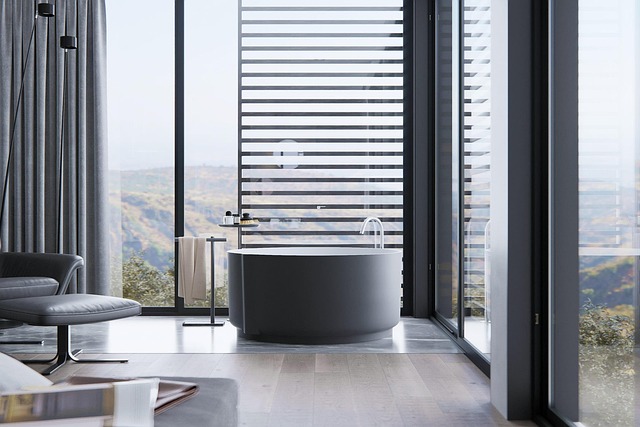A successful clawfoot bathtub remodel requires understanding basic plumbing principles for optimal functionality. This includes knowledge of water supply lines, drainage systems, and pressure management to ensure consistent, adequate water flow. Regular maintenance, such as inspecting pipes for corrosion or leaks, replacing old fittings, and upgrading aerators, enhances performance. Plumbing safety is crucial during renovation, with proper tools, protective gear, and secure work practices. Regular maintenance for older homes, including insulation and gasket replacement, prevents damage from freezing or leaks, ensuring a smooth clawfoot bathtub remodel experience.
Ensure optimal functionality and enjoyment of your clawfoot bathtub remodel with proper plumbing and water pressure. This comprehensive guide explores essential aspects, from understanding basic plumbing principles to maintaining regular upkeep. Learn about ideal water pressure for a relaxing bath, assess and improve water flow in older homes, and discover safe tools and techniques for plumbers. Implement these tips to prevent future plumbing issues and revel in a beautifully remodeled clawfoot bathtub.
Understanding Plumbing Basics for Your Clawfoot Bathtub Remodel
When embarking on a clawfoot bathtub remodel, understanding basic plumbing is crucial for achieving optimal functionality and ensuring your investment pays off. Plumbing involves the intricate network of pipes that delivers water to fixtures like your bathtub, shower, and sinks. Familiarizing yourself with this system will help you navigate any potential challenges during the remodel process.
The key components include water supply lines, which bring water into your home from the main supply, and drainage systems that safely remove water and waste. In a clawfoot bathtub setup, proper plumbing ensures a consistent and adequate water flow for bathing, while also managing pressure to prevent leaks or clogs. Regular maintenance and understanding basic repairs can keep your plumbing running smoothly, enhancing the overall experience of your clawfoot bathtub remodel.
Water Pressure Requirements for Optimal Bathing Experience
Achieving the perfect bathing experience starts with understanding water pressure requirements, especially when it comes to a classic clawfoot bathtub remodel. For optimal comfort and relaxation, water pressure should be consistent and strong enough to provide a soothing yet invigorating spray. Typically, a water pressure of 60-80 psi (pounds per square inch) is ideal for most standard showerheads and faucets. This range ensures that the water flows gently yet effectively around the body, enhancing the overall bathing experience without causing any discomfort or strain.
In a clawfoot bathtub remodel, where aesthetics meet functionality, maintaining this specific pressure range becomes even more crucial. The right water pressure not only enhances the bath’s therapeutic benefits but also adds to its visual appeal. A balanced flow prevents excessive splashing while still allowing for a refreshing and rejuvenating soak. This is particularly important for those who enjoy longer baths or seek a spa-like experience in their own home, making it an essential consideration during any bathroom renovation project.
Assessing and Improving Water Flow in Older Homes
Many older homes feature charming fixtures, such as clawfoot bathtubs, but their plumbing might not meet modern standards. Assessing and improving water flow in these homes is crucial for optimal functionality and a satisfying remodel experience. Start by inspecting the pipes—look for any signs of corrosion, leaks, or blockages that could restrict water flow. Tight bends and old fittings often slow down water movement, so consider replacing these components with newer, more efficient models.
A simple upgrade like swapping out aerators can significantly enhance water pressure in both sinks and bathtubs. Additionally, checking the main water valve and ensuring it fully opens is essential. In many cases, a partial restriction at this point could reduce water pressure throughout the entire home. Regular maintenance and these strategic improvements will ensure smooth water flow during your clawfoot bathtub remodel, providing both efficiency and a luxurious experience.
Essential Tools and Techniques for Plumber Safety
When it comes to plumbing, safety is paramount, especially during a clawfoot bathtub remodel. Plumbers often encounter a variety of challenges and hazards on the job, so being equipped with the right tools and implementing important techniques is crucial. Essential tools include leak detection equipment, pressure gauges, and protective gear like gloves, eye wear, and earplugs to prevent injuries from sharp objects or loud noises.
For a clawfoot bathtub remodel, specialized tools such as adjustable wrenches for tight spaces and pipe cutters for precise cuts are invaluable. Additionally, understanding and following safe work practices, including proper ventilation, dewatering areas, and securing water supply lines, ensures the well-being of plumbers and prevents potential damage to the property during the renovation process.
Regular Maintenance Tips to Prevent Future Plumbing Issues
Regular maintenance is key to preventing future plumbing issues, especially in older homes with traditional fixtures like a clawfoot bathtub remodel. A simple yet effective strategy is to schedule periodic checks where all water valves and pipes are inspected for any signs of corrosion, leaks, or blockages. Cleaning these components can help maintain optimal water pressure throughout the home, ensuring that every faucet flows smoothly and efficiently.
Additionally, consider insulating exposed pipes in colder climates to prevent freezing during winter months. This simple step not only protects your plumbing but also prevents potential damage from burst pipes. Regularly checking and replacing worn-out gaskets and washers can also prevent unexpected leaks, saving you from costly repairs down the line.
A successful clawfoot bathtub remodel requires careful consideration of plumbing basics. Understanding water pressure requirements, assessing older homes’ water flow, and implementing regular maintenance are essential for a seamless and enjoyable bathing experience. By equipping yourself with the right tools and techniques, you can ensure proper plumbing functionality and prevent future issues, making your clawfoot bathtub a stunning focal point in your home.
